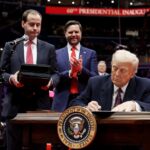“What does winning this competition with China look like? When can we say we won?” A colleague from a fellow think tank posed these straightforward but weighty questions while we were waiting our turn at a lunch buffet. It was my first in-person conference in well over a year and exactly the kind of moment that the myriad of virtual gatherings many of us have sat through the past year and a half can’t capture. A spontaneous, insightful remark on the margins of a thought-provoking gathering to discuss the future of US-China relations. Coming up with an answer is not an exercise in Beltway wonkery — the eventual answer will have a profound long-term impact on all facets of American society.
We need to drop the talk of a new “Cold War” to describe the tense US-China rivalry. It isn’t one. Instead, it’s an unprecedented contest between two economic powerhouses with widespread interdependencies.
Answering that question means articulating a strategic vision for the United States, a vision with a timeline of decades. That objective, and the actions American society will need to take to achieve it, will have outsized influence over US foreign, domestic, and economic policies for generations. President Joe Biden and Congress are taking important initial steps, such as addressing supply chain vulnerabilities, boosting R&D funding, and engaging with allies. Leaders from civil society and industry are producing untold recommendations ranging from tax incentives to new government agencies to moonshot technology development efforts.
Missing, though, is the overarching context in which these actions should take place. The US government needs to articulate a national technology strategy for an era of sustained competition with a highly capable contender. A national technology strategy includes how the US invents, innovates, and deploys technologies — such as biotech, quantum computing, microelectronics, energy storage, etc. — to compete economically while securing its national interests. In a recent report, Megan Lamberth and I make the case for the United States crafting, executing, and updating its technology policies via a comprehensive framework. The goal, and the answer to my colleague’s questions, should be this: To maintain the United States’ standing as the world’s premier technology power so that it can empower its citizens, compete economically, and secure its geostrategic interests without having to compromise its values or sovereignty.
CREATING A COMPREHENSIVE FRAMEWORK
How can the United States create a comprehensive and practical framework to compete with China? Our political leadership must start by acknowledging the nature of the China challenge and the political and economic realities involved. An ascendant and revisionist China presents a foundational challenge to the national and economic security and the liberal democratic values of the United States and its allies. As technology — an enabler of economic, political, and military power — is front and center in this competition, rising to the challenge will require profound changes to tech-focused governance, and industrial and national security policies. It also means revisiting long-standing assumptions about the foundations of American competitiveness — from R&D investments to human capital — and rethinking the feasibility of desired end states, such as industrial self-sufficiency that dominate American political discourse. Three fundamental shifts are needed.
First, and most immediately, this means dropping talk of a new “Cold War” to describe the tense US-China rivalry. It isn’t one. Instead, it’s an unprecedented contest between two economic powerhouses with widespread interdependencies. While the thrust of the Cold War was largely military and ideological, the current strategic competition is more technological and economic in nature, demanding new actions for a new era. The key focus of these actions should be to assure technology leadership by the United States and like-minded countries, essential to promoting economic competitiveness, maintaining military strength, and safeguarding liberal democratic values.
Second, a new concept of national security is needed. Economic security and national security are today effectively one and the same. How the US government is structured and the kinds of policies it enacts needs to reflect this. Doing so well will require creating new “bureaucratic connective tissue” — a reorientation of government to navigate waters largely untouched since the Reagan administration. This means creating new processes to implement technology competition policies and making existing processes better, for example, by exercising executive authorities. It will require updates to laws including the International Emergency Economic Powers Act and regulations and crafting new legislation, such as for a national data protection and privacy law. It will also involve reorienting and expanding the authorities of entities, such as the Department of Commerce.
Finally, the US government must take greater part in matters of technology policy. The hands-off approach of recent decades, such as a dearth of regulations on AI and surveillance technologies and taking a back seat to industry in funding R&D, is not up to the task of securing America’s long-term economic and technological competitiveness. It is also an anomaly. The United States has a rich history of planning and executing successful technology strategies, from Alexander Hamilton to the Space Race. The Congress and White House must rise to the occasion once more by reinvesting in science and technology and human capital — the bedrock of American competitiveness. A successful national technology strategy is about regaining the initiative in a new era of strategic competition.
WINNING IS ABOUT MORE THAN CHINA
Ultimately, though, “winning” this competition isn’t just about China. It’s a renewal of broad-based affirmative policies that enhance the United States’ ability to pursue economic prosperity, protect national security interests and democratic values, and advance society. That is the ultimate victory, and one that all Americans should strive for.
Martijn Rasser is a senior fellow and director of the technology and national security program at the Center for a New American Security.














